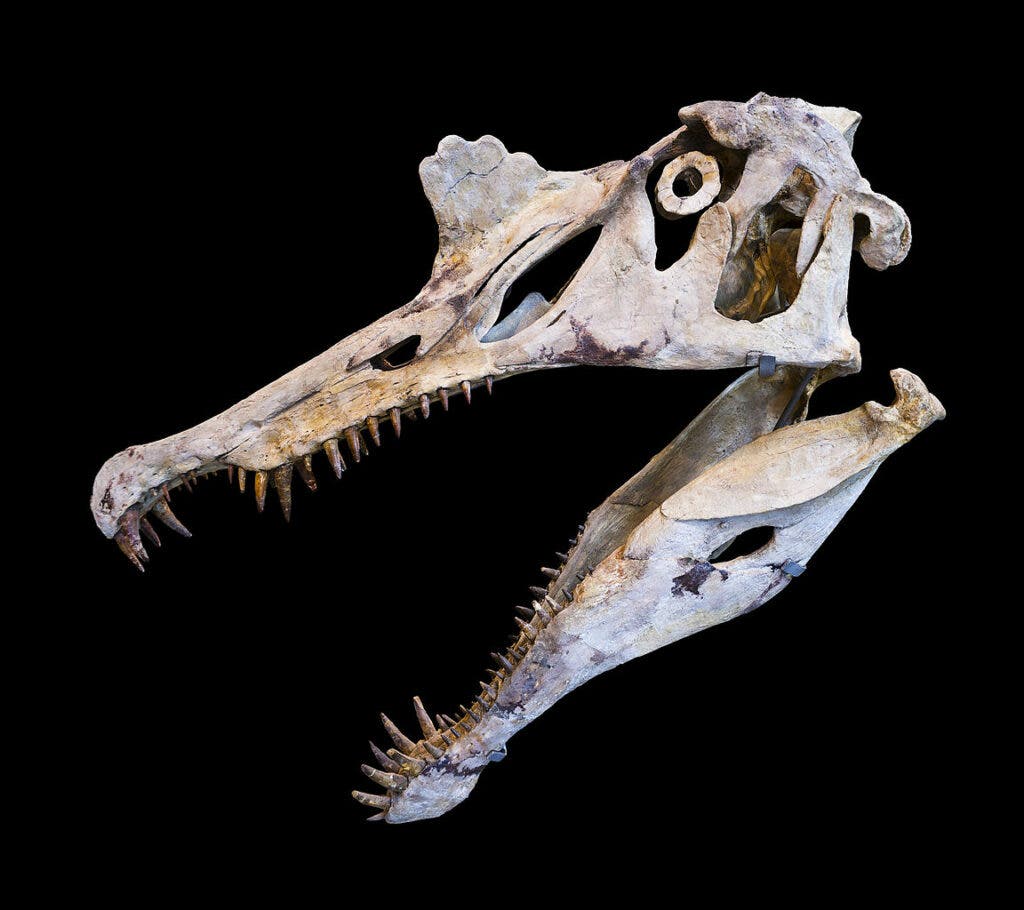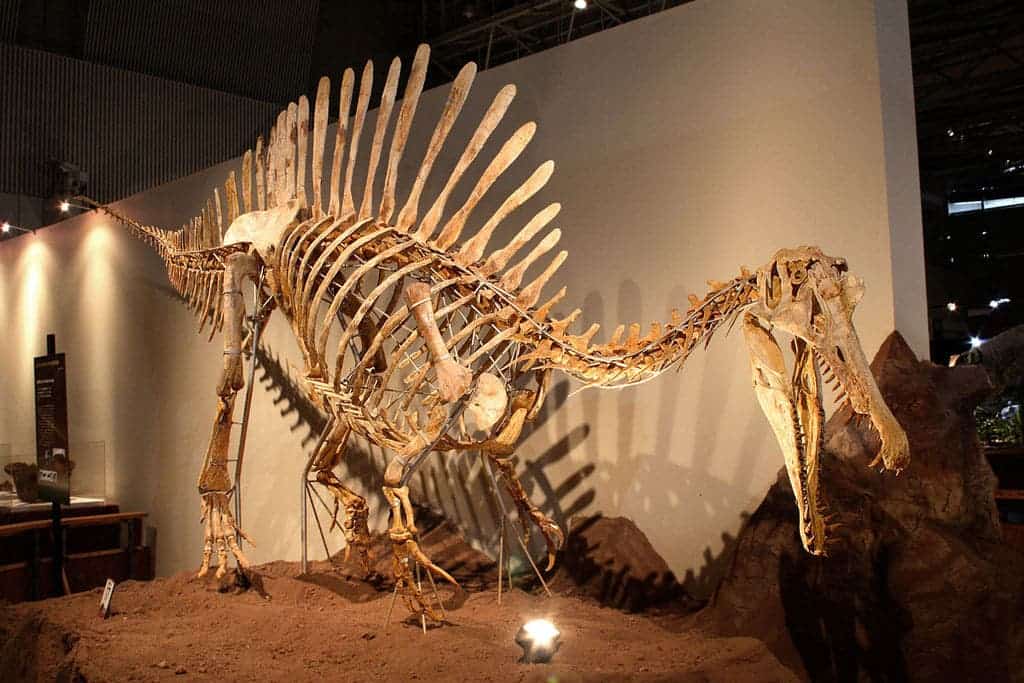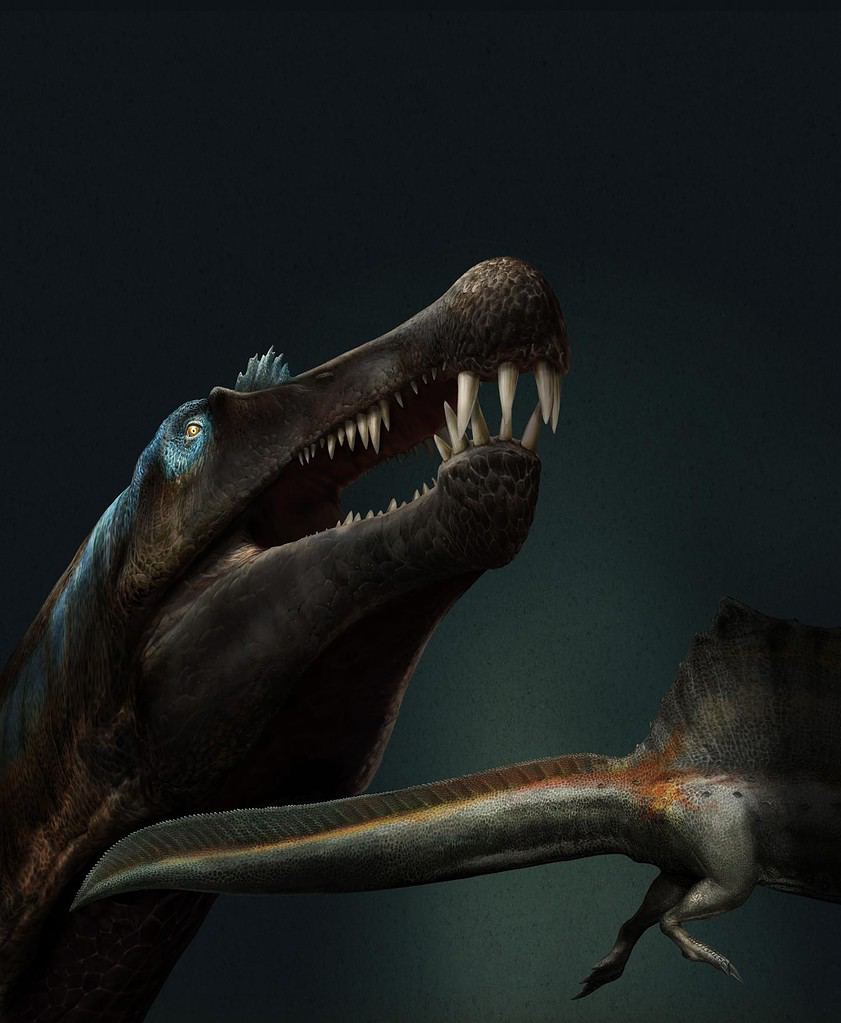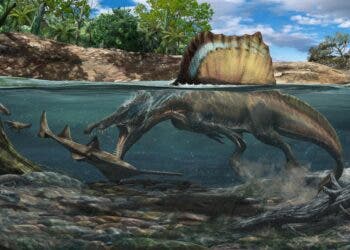Spinosaurus is a fascinating dinosaur that continues to baffle and intrigue scientists. This dinosaur roamed the land during the Cretaceous period (not the Jurassic) and is a contender for the largest carnivorous dinosaur. But there’s far more that makes the Spinosaurus so interesting. From its spines to its teeth, let’s see what made this dinosaur so remarkable.

How we found Spinosaurus
Spinosaurus aegyptiacus is an impressive species. But as impressive as this gargantuan dinosaur is, we almost didn’t know about it.
Spinosaurus fossils remain rare even to this day, and we’ve yet to find a complete specimen. Even so, reconstructions of its skeleton paint the picture of a frankly terrifying, lithe predator. T-Rex might dominate the public imagination through its brutal renderings from Jurassic Park, but you definitely wouldn’t want to meet a Spinosaurus out in the forest, either.
Perhaps ironically for a semi-aquatic dinosaur, the first Spinosaurus fossils were discovered in the deserts of Egypt. The species was described based on this incomplete specimen by Ernst Stromer, a German paleontologist, in 1915. The actual discovery of the fossils was the accomplishment of Stormer’s assistant, Richard Markgraf, who unearthed them in 1912.
The specimens were taken to the Palaeontological Museum in Munich where they remained as part of the Bavarian State Collection of Paleontology until the Second World War. Heavy bombing of the city under British air squadrons in April 1944 led to the destruction of the museum and the precious, at this time singular, Spinosaurus specimen. For over four decades, the species was functionally lost to science. The only materials available that could provide any information on Spinosaurus were Stormer’s descriptions of the fossils.
Between the 1990s and 2000s, however, archeologists working in Morroco re-discovered the Spinosaurus. This is considered to be a different species, Spinosaurus maroccanus, although that is in no way a settled matter yet. Even so, these discoveries did go a long way towards helping us better understand the dinosaur’s history.
Today, our understanding of the species has been bolstered by additional fragmented findings in Northern Africa. Here’s what we’ve learned about the Spinosaurus.
Spiny Lizard

Spinosaurus was a theropod dinosaur from the Spinosauridae family that lived during the Late Cretaceous, 95-70 million years ago. Theropods are dinosaurs with hollow bones and three toes and claws on each limb. Tyrannosaurus is another notable example in this group.
But the Spinoasaurs were very different from the Tyrannosaurus, in particular because of its massive sail-like spine and elongated snout.
The name Spinosaurus (pronounced spine-oh-sore-us) comes from a distinctive structure on the animal’s back — a spiny or “sail-back” ridge. We know of other species that sported a similar feature (such as Dimetrodon, which was a non-mammalian synapsid) so it’s not entirely distinctive to spinosaurids (dinosaurs related to Spinosaurus). Still, as is the case with all of them, we don’t really know what the purpose of these ridges was.
Early theories proposed they helped maintain the animals’ body temperature inside an optimal range (a process known as ‘thermoregulation’) but these have largely been ruled out. Our best bet right now is that the spiny lizards’ spines were used more for display purposes, maybe for a bit of balancing, as well. Alternatively, it could have been used to intimidate potential threats, as it almost doubled the apparent body size of Spinosaurus when fully deployed.

The accurate Spinosaurus
Spinosaurus is no different from other dinosaurs in one regard: it was often misinterpreted. In fact, we still don’t yet know its full story, because complete fossils so old are very rare.
Nevertheless, what we do know about it is that it was huge. Spinosaurus is probably the biggest land predator in history, or at least the biggest one we’ve discovered so far.
Spinosaurus could grow to reach 13 to 18 meters (40 to 60 ft) in length at adulthood, although that estimate has been contested. Other sources propose lengths from 15 to 16 meters (49 to 52 ft). Part of the issue here is that we haven’t found any complete Spinosaurus specimen, which limits our ability to accurately estimate its dimensions. As for sheer mass, we believe they could reach between 7 and 21 metric tons — which, admittedly, is a large interval; but still impressive!
Based on these figures, Spinosaurus would be the largest terrestrial carnivore ever found. It would be comparable to (although larger than) other infamous carnivores such as T-Rex.
Other distinctive features of this dino were its large but slender body, an elongated crocodile-like head, straight, conical teeth, and a paddle-like tail. It also had its nostrils next to its eyes, instead of the point of its snout. These features heavily suggest that Spinosaurus was a meat-eating aquatic dinosaur. The discoveries of other spinosaurids with fish scales in regions corresponding to their digestive tract further reinforce this notion. But these features don’t really point to an exclusively aquatic species.
But although Spinosaurs couldn’t really swim (or at least not long distances), it was pretty fond of water. In fact, there’s still a lot of debate regarding this dinosaur’s relationship with water.
Aquatic spinosaurus?
We presume that Spinosaurus, and likely other related spinosaurids, were more likely semi-aquatic, living close to bodies of water but also hunting on dry land. It was a bipedal beast, with small front limbs (although not as stumpy as those of T-Rex). This layout would be better suited to walking on land or wading through shallow waters than swimming, which helped rule out a fully aquatic lifestyle.
Spinosaurus likely lived in humid environments near water — think tidal flats, mangrove forests, rivers. Not very different from how crocodilians today spend their lives. As a top predator, there was virtually nothing in its environment that it couldn’t or wouldn’t hunt. Fish, turtles, other dinosaurs of all kinds, from flying pterosaurs to the swimming plesiosaurus, were probably on the menu. The shape of its teeth and position of its nostrils, however, suggest that it was mainly a fish-eating species.
But there’s still plenty of debate around how exactly Spinosaurus hunted.
Hunting in the water, or stalking like a heron?

In the last decade, University of Portsmouth paleontologist and National Geographic Explorer Nizar Ibrahim has unearthed different parts of a Spinosaurus skeleton in North Africa’s Sahara Desert. Ibrahim describes the quest:
“We battled sandstorms, flooding, snakes, scorpions and more to excavate the most enigmatic dinosaur in the world and now we have multiple lines of evidence all pointing in the same direction – the skeleton really has “water-loving dinosaur” written all over it!”
Dr Ibrahim and his team previously suggested that Spinosaurus could swim and actively pursue prey in the water. But this is a hotly debated idea.
“In part this is probably because we were challenging decade-old dogma – so even if you have a very strong case, you kind of expect a certain degree of pushback,” Dr Ibrahim said.
So the researchers looked at the Spinosaurus’ bones. They found that the bones were denser than those of other dinosaurs (and current birds). This would have helped it swim and chase its prey underwater. In the new study from 2022, the researchers conclude that Spinosaurus wouldn’t have simply stalked its prey in water — it would have actively hunted in water.
“I think that, with this additional line of evidence, speculative notions that envisage Spinosaurus as some sort of giant wader lack evidential support and can be safely excluded. The bones don’t lie, and now we know than even the internal architecture of the bones is entirely consistent with our interpretation of this animal as a giant predator hunting fish in vast rivers, using its paddle-like tail for propulsion. It will be interesting to reconstruct in a lot more detail how these river monsters moved around – something we are already working on,” Ibrahim explains
“This discovery is the nail in the coffin for the idea that non-avian dinosaurs never invaded the aquatic realm,” said Ibrahim. “This dinosaur was actively pursuing prey in the water column, not just standing in shallow waters waiting for fish to swim by. It probably spent most of its life in the water.” The discovery also points to the possibility of a persistent and widespread invasion of aquatic habitats by relatives of Spinosaurus.
A bizarre dinosaur
But the Spinosaurus is not easy to understand. In fact, even the researchers working on this dinosaur are finding it hard.
“Spinosaurus was a bizarre animal even by dinosaur standards, and unlike anything alive today, so trying to understand its ecology will always be difficult,” said Tom Holtz, Principal Lecturer in Vertebrae Paleontology, University of Maryland, upon publishing a study on Spinosaurus behavior.
The evidence uncovered by Holtz and colleagues points to Spinosaurus feeding partly, even mostly, in the water, probably more so than any other large dinosaur. But that is a different claim than it being a rapid swimmer chasing after aquatic prey.
“Whilst our study provides us with a clearer picture of the ecology and behaviour of Spinosaurus, there are still many outstanding questions and details to examine for future study and we must continue to review our ideas as we accumulate further evidence and data on these unique dinosaurs. This won’t be the last word on the biology of these amazing animals.”
Still plenty left to uncover about Spinosaurus
This is just one aspect about Spinosaurus — and it took years and years of work and research to uncover it — and it’s still not settled.
That’s how difficult it is to truly understand dinosaurs. These creatures lived tens of millions of years ago, and while they left some clues to their behavior, it’s extremely challenging to piece together a comprehensive picture. The fragmented, rare fossil record of Spinosaurus adds an extra layer of complexity to this puzzle.
What we know for sure is that Spinosaurus represents a fascinating blend of adaptations, a creature at home both in the water and on land, wielding a unique set of tools for survival in its environment. Its elongated snout, sail-like spine, and powerful body structure all hint at a predator with a specific lifestyle and set of behaviors that set it apart from other dinosaurs of its time.
Spinosaurus is a testament that even the most fearsome of predators need to have specialized roles and behaviors that enable them to thrive in their ecosystems. This research into Spinosaurus not only reveals more about the world of the dinosaurs, but about the evolution of life as a whole. As scientists continue to dig, analyze, and hypothesize, the story of Spinosaurus will surely evolve, reflecting the dynamic nature of paleontological research — and our understanding of life and evolution.
Spinosaurus FAQ
Spinosaurus is a genus of theropod dinosaur that lived approximately 112 to 93 million years ago during the Cretaceous period. It is known for its distinctive sail-like spine and is considered to be one of the largest carnivorous dinosaurs.
Spinosaurus fossils have primarily been found in North Africa, including countries such as Egypt, Morocco, and Tunisia.
Spinosaurus is believed to have been a semi-aquatic predator, mainly feeding on fish. Its elongated, crocodile-like snout and conical teeth were likely adapted for catching slippery aquatic prey.
Spinosaurus is estimated to have reached lengths of up to 50-59 feet (15-18 meters) and may have weighed between 7 to 20 tons. Its size makes it one of the largest carnivorous dinosaurs.
The function of the Spinosaurus’s sail is still debated. Some theories propose that it was used for temperature regulation, while others suggest it could have been a display feature for attracting mates or intimidating rivals.
Though research is ongoing, some evidence suggests that Spinosaurus may have been a proficient swimmer. The structure of its bones and its potential diet of fish indicate that it might have spent significant time in the water.
Unlike the T-Rex, which was primarily a land-based predator, Spinosaurus’s anatomy suggests that it was adapted for a semi-aquatic lifestyle. Its diet, habitat, and physical characteristics like the sail and snout make it unique among large theropod dinosaurs.
Many of the original Spinosaurus fossils were destroyed during World War II when the museum in Munich where they were housed was bombed. Since then, new discoveries have helped to rebuild our understanding of this fascinating creature.
Yes, replicas and some original Spinosaurus fossils are on display in various museums around the world. Research is ongoing, and new findings are continually enhancing these exhibits.
Spinosaurus provides a unique window into the world of the Cretaceous period in North Africa. Its unusual characteristics, such as its sail and semi-aquatic nature, offer insights into dinosaur evolution, behavior, and ecology. Its story of discovery, loss, and rediscovery also underscores the importance of preserving and studying fossils for future generations.
Spinosaurus lived during the Cretaceous period, specifically in the Albian to Cenomanian stages, around 112 to 93 million years ago.
Modern paleontologists use a combination of newly discovered fossils, existing specimens, and advanced technology like CT scans to study Spinosaurus. This multifaceted approach helps to reconstruct its appearance, behavior, and place in the ecosystem.
This article was edited. The original version wrongly claimed that Dimetrodon was a dinosaur.



